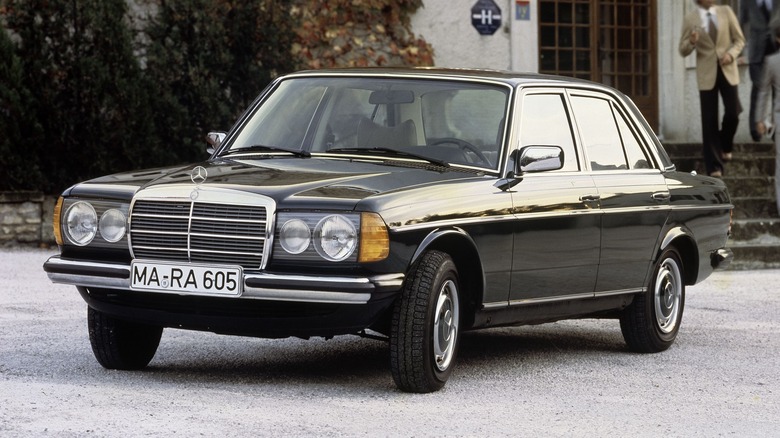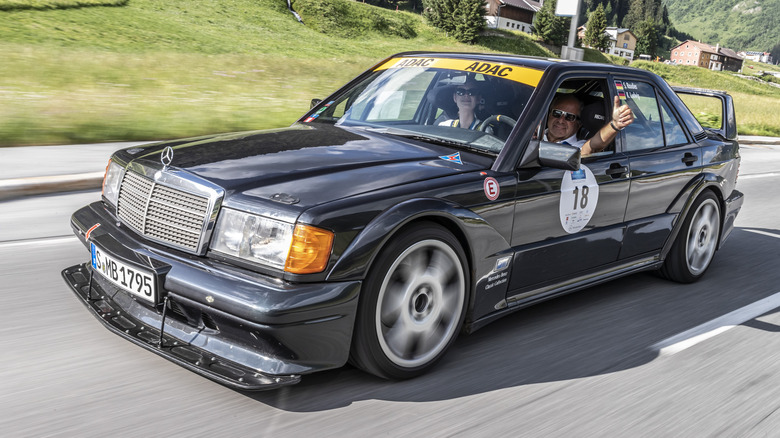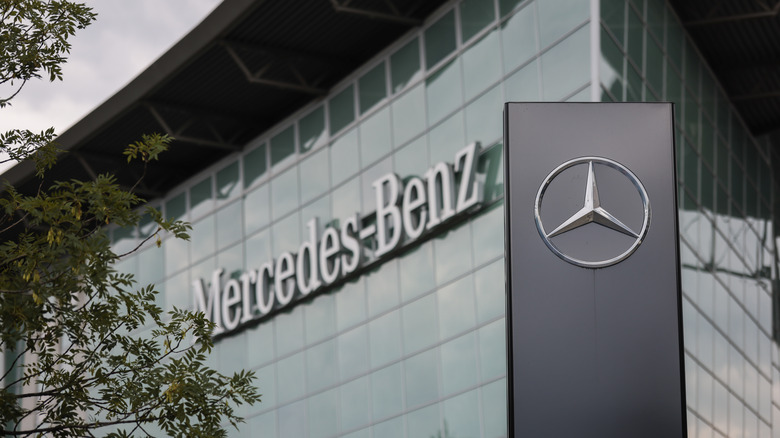The 10 Best Mercedes-Benz Models Ever Designed
Since the formation of Carl Benz's engine manufacturing company in the 1880s, the automaker now known as Mercedes-Benz has been at the forefront of the industry. The company produces a much wider range of vehicles than some enthusiasts might think, churning out everything from off-road firetrucks to premium compact hatchbacks.
However, most will know Mercedes-Benz primarily for its range of luxury and performance cars, which include some of the most iconic names in their respective segments. Many of the cars in the brand's lineup today are direct descendants of these icons, with some even sharing styling and nameplates with their revered predecessors.
Even with such a large back catalog to choose from, a select few Mercedes-Benz models stand above the rest as milestones in the company's history. Whether they were great feats of engineering, boasted pioneering technology, or simply captured the imaginations of enthusiasts the world over, these cars are Mercedes-Benz's greatest designs so far.
Mercedes-Benz SLR McLaren
The Mercedes-Benz SLR McLaren was the first and only roadgoing supercar to be jointly developed between the two manufacturers. It was announced in 1999 and would be first shown off in production guise at the Frankfurt Motor Show in 2003. Demand for the car was strong from launch, with over 2,000 examples produced by the time production ended in 2009, alongside a slew of special edition variants.
The SLR was different from other landmark supercars released during the same era, in that it was less of an all-out track car and more of a long-distance tourer. However, it could still keep up with any of its contemporaries in a straight line thanks to its AMG-developed supercharged 5.5L V8 engine, which produced around 620 horsepower.
In the years since production ended, McLaren has continued to offer upgrades and conversions for the car, the most recent being the SLR High Downforce Kit, launched in 2023. Interest in the car from collectors has remained very strong over the years, and given that no direct successor ever emerged from the now defunct Mercedes-McLaren partnership, that seems set to continue for the foreseeable future.
Mercedes-Benz G-Class
Originally developed as a military vehicle, the Mercedes-Benz G-Class has evolved into a flagship luxury off-roader over its decades on sale. The latest generation is more luxurious and technologically advanced than ever, yet it doesn't lose the all-terrain toughness that made it an icon. It retains its traditional body-on-frame construction even in an era when many SUVs have moved to unibody construction to improve driving dynamics and weight, and its beefy tires and toughened suspension ensure that it can dispatch all kinds of terrain without breaking a sweat.
These capabilities come at a steep price, with the base-spec 2024 G-Class retailing for over $140,000 and well-optioned AMG models nearing the $200,000 mark. For that price, buyers get a range of powerful engines, with the top-spec AMG V8 engine pushing out over 500 horsepower. Inside, the G-Class offers levels of luxury similar to the flagship S-Class sedan, with plenty of lavish optional extras available for those with especially deep pockets. Few, if any, other SUVs on the market offer both the exceptional luxury and go-anywhere capabilities of the G-Class, and it's stayed a favorite among the rich and famous since it was first officially introduced to the American market more than 20 years ago.
Mercedes-Benz SL Pagoda
Earning its nickname from its upright pagoda-like glasshouse, the Mercedes-Benz W113 SL is one of the most instantly recognisable cars of its era. It was first launched in 1963 and survived until 1971, with many of the era's most famous faces having one in their garage. Stars ranging from John Lennon to Sir Sterling Moss were pictured behind the wheel of an SL Pagoda, and as a result, they've earned an enduring air of celebrity about them, drawing attention wherever they go. Of course, this isn't just down to their famous owners. It's just as much about the car's clean, elegant lines and timeless styling.
Few other convertibles look quite as eye-catching, especially with the roof down and at cruising speeds. The SL wasn't built to go fast, but can be if needed, with 150 horsepower on tap from its straight-six engine. Unsurprisingly given its evergreen appeal, the Pagoda is far from the cheapest Mercedes on the market, with well-sorted examples fetching six-figure sums at auction.
Mercedes-Benz 300SL Gullwing
The precursor to the W113 SL is just as important in the brand's history, and even more valuable. The 300SL Gullwing was the first Mercedes-Benz sports car designed primarily for the road rather than the track, and was built at the request of an American importer, Max Hoffman. Responding to the demand from U.S. buyers, Hoffman petitioned company executives to make a road-oriented version of the 300SL race car that had already proven successful in competition. Converting the race car for road use required solving several key engineering hurdles, one of which was ensuring that occupants could get in and out of the car.
The race car's space frame was very lightweight, but its structure meant that the use of regular car doors was not possible. So, engineers developed the distinctive "gullwing" doors for easier entry and exit, earning the car its long-standing nickname. Hoffman's prediction of high demand proved correct, with over 1,400 examples of the car eventually produced. Surviving examples now fetch seven figures at auction, and one extremely rare variant even became the most expensive car ever sold. A deal was struck in 2022 for a 300 SLR Uhlenhaut Coupe to change hands for an eye-watering $142 million.
Mercedes-Benz 600 Pullman
The "Grand Mercedes" was a favorite of many world leaders and celebrities during its nearly two decades on sale, with 2,677 examples of the 600 produced. Of those cars, only around 300 were the top-spec 600 Pullman limousine. Each one was hand-built to the exacting tastes of its commissioner, with some cars having TVs, minibars, or conference seating for on-the-go meetings. Few cars were as lavish, and almost none were as expensive.
Rather than using electronic systems, the 600's power windows and adjustable seats used unique hydraulic systems that had been developed specially for the car. As a result, each requires the attention of not just a marque specialist, but one with particular knowledge of the 600. Few qualified specialists remain around the world, making the 600 an extremely expensive car to maintain. Its rarity and status have ensured that examples remain costly to purchase, selling for hundreds of thousands of dollars on the rare occasion they appear for sale.
Mercedes-Benz W123
It might not be the most expensive nor the rarest classic Mercedes, but few cars encapsulate the brand's reputation for bulletproof luxury vehicles better than the W123. Not literally bulletproof — that distinction was saved for high-end limousines like the 600 — but figuratively, in the sense that it could deal with plenty of abuse and remain unwaveringly reliable. That has kept the car a popular choice in countries with harsher roads and environments, but it has also ensured that it retains a strong fanbase in Europe and America. Alongside pristine collector examples, the W123 is also a firm favorite among buyers looking for an affordable project car.
Many body styles and engine options were available, but all were considered equally durable. The car's popularity over its time on sale has meant that plenty of examples are still floating around on the used market today, making them one of the most attainable great Mercedes-Benz cars. Coupe models are considerably rarer than their sedan and wagon counterparts, with less than 100,000 examples reportedly produced out of a total production run of around 2.7 million cars.
Mercedes-Benz 190E 2.5-16 Evo II
Racing homologation rules have had a hand in creating many of the greatest classic road cars, with one such car being the Mercedes-Benz 190E 2.5-16 Evo II. A total of 502 examples were built to allow Mercedes to enter the DTM touring car championship, each featuring a 232-horsepower four-cylinder engine and a distinctive body kit that mirrored the competition car. The Evo II retailed for over three times the price of a base spec 190E, but buyers who held onto the car will have a healthy return on their investment today.
The racing version of the 190E proved extremely successful on the track, winning the DTM championship for three consecutive years, with two of those seeing the car take a 1-2 finish. This in turn reinforced the appeal of the road car, which given its impressive performance and eye-catching looks, had already found favor with well-heeled enthusiasts.
Mercedes-Benz 540K
The 540K is one of the most luxurious Mercedes-Benz models ever built, as well as one of the most desirable pre-war cars for collectors. Alongside its direct predecessor the 500K, it was built to appease the brand's most discerning customers, who wanted a luxurious sport tourer but thought the brand's earlier offering, the 380, wasn't powerful enough. The change from the 3.8L engine to the 5.0L unit satisfied most of those clients, but the additionally powerful 5.4L unit was considered the ultimate variant of the car.
It could be optioned either as a fully built car from the factory or as a chassis with which a coachbuilder could create a custom body. A handful of the surviving coachbuilt cars have been restored and make occasional appearances at leading concours events like Pebble Beach, with one example winning best of show in 2023. Unsurprisingly for such a desirable car, resale values are eye-watering. Most command upwards of $1 million, while the most sought-after examples have sold for over $9 million.
Mercedes-Benz SLS AMG
AMG and Mercedes-Benz first officially collaborated on a car with the unveiling of the C36 AMG in 1993. However, the first time that AMG would be tasked with creating a car from the ground up would be the SLS AMG. The car drew inspiration from several sources, including from Mercedes' own classic models. The 300SL Gullwing was evidently a major source of inspiration and gave the SLS AMG its signature doors. Unlike the older car, those doors were no longer at risk of trapping occupants in the case of a rollover thanks to a brilliantly devised door detachment system that used small explosives to automatically break off the doors when a crash occurred.
The door system was just one of several pioneering developments on the SLS AMG, but aside from being technologically advanced, it was also a performance pioneer for the brand. By the time the Black Series car was unveiled in 2014, the 6.3L V8 engine produced 622 horsepower and boasted a 0-60 mph time of just 3.5 seconds. Those figures made the SLS AMG one of the fastest Mercedes production cars ever built, beating the likes of the CLK GTR.
Mercedes-Benz CLK GTR
The fact that it would take years for the CLK GTR's performance to be outshone is testament to the '90s supercar's capability. The road going CLK GTR was built to homologate the racing version, a car so good that it's credited with killing the GT1 class. It won so frequently that, just two years after its launch in 1997, every one of its competitors had withdrawn from the class. The road car was built more as a necessity to go racing than anything else, but it still turned out to be an excellent machine in its own right.
The sight of a futuristic, low-slung supercar with a mid-mounted 6.9L V12 engine turned heads everywhere it went, although with just 25 examples built, it was vanishingly rare. Of that run, 20 cars were coupes and a mere five were roadsters, with each one selling for more than $1 million. The car's scarcity, performance, and race-winning pedigree have ensured that it remains a seven-figure car today, although examples very rarely appear for sale.
Methodology
Mercedes-Benz has a huge range of iconic cars in its back catalog, and so in narrowing down the list to these, a few inevitably couldn't make the cut. To whittle the list down, we focused on cars that not only remain desirable to collectors and fans of the marque but also those that made a notable impact on the automaker as a whole. Whether they contributed technology to following cars or forged a reputation that positively impacted the perception of the Mercedes-Benz brand, each one is important to the brand's history.
Many of Mercedes' most revered cars also have more than one element of appeal — say, combining luxury and off-road capability or practicality and performance — and so preference was given to those that demonstrated excellence in multiple areas. Finally, recognition among enthusiasts was considered as a secondary criteria — after all, the brand's greatest designs are surely those that are the most appreciated among its biggest fans.











